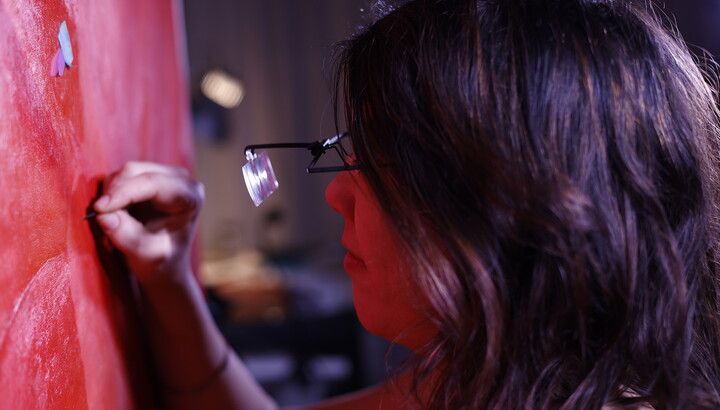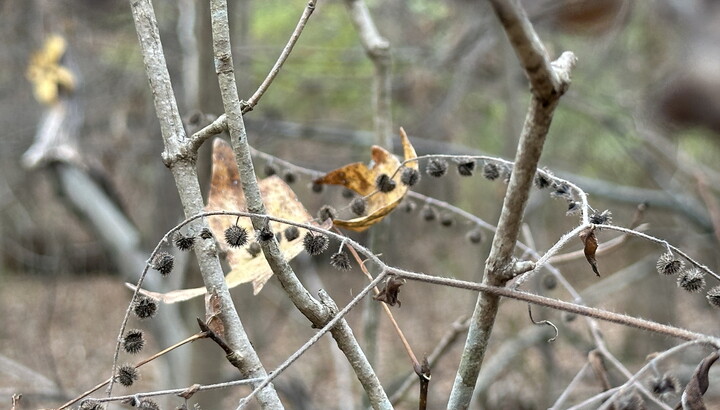The Carter Blog
Carter ARTicles
Talk to us (online), Anila
Aug 17, 2021
As a Carter member (if you’re not a member, what are you waiting for? Join now!), you receive our biannual Carter Magazine, chock-full of stories you can only get from the Carter. The current issue features excerpts from an interview with artist Anila Quayyum Agha, whose installation A Beautiful Despair opens on September 25. Below is the full interview. Don’t forget to join us for Member Preview Days on September 23 and 24!
Why did you decide to work with the Carter?
I did my graduate studies at the University of North Texas and lived in the Dallas-Fort Worth area for four years. I feel like that region was where I had my first home in the United States. I have fond memories of visiting Fort Worth to see exhibitions at the Carter, Kimbell, and Modern. I also love the Carter building designed by Philip Johnson, whom I greatly admire as I love simplicity and elegance and try to incorporate them into my own work as much as possible.
How did you come up with the idea of the cube?
On a trip to Spain seven or eight years ago, I visited the Alhambra palace complex. To me, Alhambra seemed to visually explain what we needed in our present times, based on the world’s then political discourse. I felt we needed a dialogue, harmony, honest exchange, and transparency to create abundance for all beings living on this planet. As an immigrant in the U.S. and sometimes feeling misunderstood or dismissed, I had longed for such an intersection in my own life.
So, in my first cube project, Intersections, I took my personal and seminal experience of being excluded, as a woman, from a space of community and creativity such as a mosque —which in a Third World country not only serves a religious purpose but also as a library, museum, and community center—and I tried to translate the complex expressions of both wonder and exclusion I had experienced while growing up in Pakistan and living in the States. The first cube emulated patterns from the Alhambra, which, in my mind, was poised at the intersection of history, culture, and art and was a place where Islamic and Western discourses met and co-existed in harmony and served as a testament to the symbiosis of difference. For me, the familiarity of the Alhambra, along with memories of another time and place from my past, coalesced in creating the first project.
How did you come up with your installation concept for A Beautiful Despair?
I mined inspirations and influences from diverse Islamic regions to create rich patterning through a collage approach. In my projects, my goal is to explore the binaries of public and private, light and shadow, static and dynamic as metaphors for understanding the human condition. I do that by relying on the purity and symmetry of geometric design, and the interpretation and distortion of the cast shadows in the installations.
Can you describe how you integrate sewing into your drawings and what this process means to you?
My flatwork is conceived as series of collaged drawings to explore the deeply entwined political relationships between gender, culture, religion, labor, and social codes. In my drawings I have used combinations of textile processes such as embroidery, wax, dyes, silk-screen printing, and sculptural methodologies to reveal and question the gendering of textile or craftwork as inherently domesticated and so excluded from being considered an art form. My experiences in my native country and as an immigrant are woven into my work of redefining and rewriting women’s handiwork as a poignant form of creative expression. The conceptual ambiguity of the resulting patterns create an interactive experience in which the onlooker’s subjective experiences of alienation and belonging become part of the piece and inform its identity.
What sources inspired your intricate patterns on your sculptures?
Starting with familiar Islamic motifs, that, in due course, become reinterpretations of the original designs allows me to infuse a contemplative focus suggestive of the underlying order of both the cosmos and the natural world through symmetries found in nature. These somewhat familiar Islamic geometric motifs allow me to excavate and reinterpret these motifs and patterns from the everyday and elevate them to the extraordinary, to reveal the complexities of interdependence between genders, cultures, civilizations, and the amorphous borders between them all. I am fascinated by the interplay of presumed opposites that are never quite so: male and female, the definite or the amorphous, the geometric and the organic. In my work, these concerns emerge in an exploration of topical issues, such as joy and grief, safety and danger, life and death, the seen and the unseen—my work examines the amoebic transparency of sorrow and joy, and their ability to reflect and inflict light and darkness.
How does your work relate to the world today?
Exploring the perceived cultural and social polarities permits me to delve into controversial topics that reflect upon topical themes of cultural identity, global politics, environmental concerns, mass media, and social/gender roles. Mixing reflections and shadows with solid forms and often transposing the resulting effect, my artwork aspires simultaneously to be perceptually soothing and conceptually challenging. To clarify, my work is not about religions, but a contemplation on the nature of boundaries and alienation, and on the power of dialogue to transcend barriers that prevent the true intersections and exchanges between us.
What do you hope people come away with after viewing your exhibition?
I have realized that, regardless of the color of one’s skin, gender identity, or religious affiliation, striving for justice is a hard and lonely road. I am concerned for the world we are leaving for our future generations. With the current protests taking place in the U.S.A., viewed as a beacon of democracy for the world, I am hopeful that real change may occur to ensure all people have recourse to justice and hope. I want A Beautiful Despair to remind us that there is inherent beauty in every single being on this earth and we need to respect, love, and enhance our possibilities. I feel we are standing on a precipice of despair and beauty.






